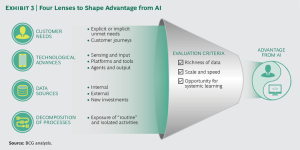Until recently, artificial intelligence (AI) was similar to nuclear fusion in unfulfilled promise. It had been around a long time but had not reached the spectacular heights foreseen in its infancy. Now, however, AI is realizing its potential in achieving human-like capabilities, so it is time to ask: How can business leaders harness AI to take advantage of the specific strengths of man and machine?
AI is swiftly becoming the foundational technology in areas as diverse as self-driving cars and financial trading. Self- learning algorithms are now routinely embedded in mobile and online services. Researchers have leveraged massive gains in processing power and the data streaming from digital devices and connected sensors to improve AI performance. And machines have essentially cracked speech and vision specifically and human communication generally. The implications are profound:
- Because they know how to speak, read text, and absorb and retain encyclopedic knowledge, machines can interact with people intuitively and naturally on a wide range of topics at considerable depth.
- Because they can identify objects and recognize optical patterns, machines can leave the virtual and join the real world.
A field that once disappointed its proponents is now striking remarkably close to home as it expands into activities commonly performed by humans. AI programs, for example, have diagnosed specific cancers more accurately than radiologists. No wonder that traditional companies in finance, retail, health care, and other industries have started to pour billions of dollars into the field.
Because AI systems think and interact, they are invariably compared to people. But while humans are fast at parallel processing (pattern recognition) and slow at sequential processing (logical reasoning), computers have mastered the former in narrow fields and are superfast in the latter. Just as submarines don’t swim, machines solve problems and accomplish tasks in their own way.
Without further quantum leaps in processing power, machines will not reach artificial general intelligence (AGI): the combination of vastly different types of problem-solving capabilities—the hallmark of human intelligence. Today’s robo-car, for example, doesn’t exhibit what we would consider common sense, such as abandoning an excursion to assist a child who has fallen off her bicycle. But when properly applied, AI excels at performing many business tasks quickly, intelligently, and thoroughly.
Artificial intelligence is no longer an elective. It is critical for companies to figure out how humans and computers can play off each other’s strengths as intertwined actors to create competitive advantage.
…
We advocate looking at AI through four lenses:
- Customer needs
- Technological advances
- Data sources
- Decomposition of processes
by Philipp Gerbert, Jan Justus, and Martin Hecker
More: BCG
